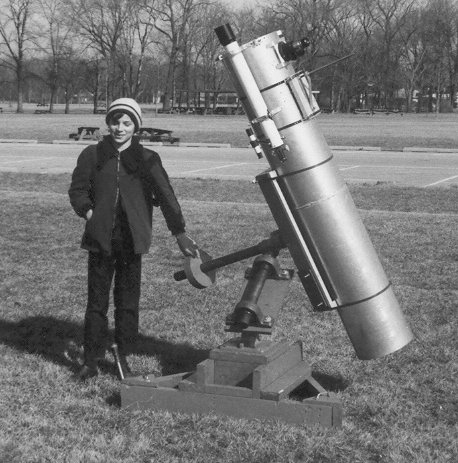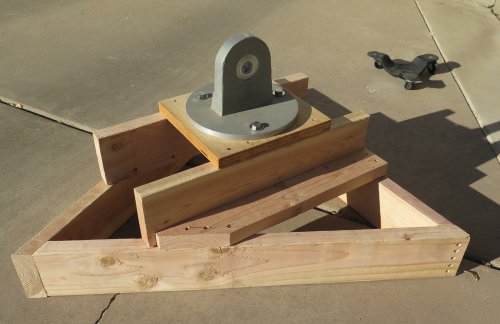Bringing the 10" Scope Back to Life

When I was 14, I took an opportunity and started out on a very large project: A friend of mine bought an Edmund Scientific mirror-making kit, decided he didn't have the time to pursue it, and sold it to me. The kit included a 10" Pyrex mirror blank, a plate glass tool blank, and all the abrasives needed to grind and polish it. I did most of the grinding in my basement, using a defunct round wringer washer as a grinding station. I followed the instructions in the kit, along with whatever I could find in the library, and though it took a couple of months, in time I had a Pyrex blank with a smooth curve, focusing at about 67 inches. My goal was 70, so I came pretty close, and in truth, 67" would make for a shorter and somewhat lighter tube.
Now, grinding is only half the job. Polishing the ground mirror surface took sophisticated methods to gauge the accuracy of the curve, which has to be a parabola to focus items at infinity (like stars) to a sharp image. I decided I was over my head, and did the sensible thing: I enrolled in a class at the Adler Planetarium on Chicago's lakefront, which took up most of the summer that I turned 15. They had an optical shop in the basement that included the required Focault tester, plus a superb teacher, Ken Wolf, who helped me get the polishing done and mirror curve accurate. They were also able to aluminize it, and by that fall, I had a 10" F6.7 parabolic telescope mirror accurate to 1/25 wave, which was bogglingly accurate for a first shot by a 15-year-old.
The rest of the scope took another two years and change to complete. A friend's father made me a tube out of sheet aluminum. I built a tube saddle out of scrap wood and hardware-store aluminum stock. I had no tools more sophisticated than my dad's circular saw and saber saw. And that was for woodworking--for metal I did it all with a hacksaw and files. I had some help from my high school machine shop teacher, who dug up a piece of iron that he said was hull metal from a scrapped battleship. He cut it to size on the big bandsaw for me. I spent many study hall hours in his shop on one of the lathes, boring out 2" pipe fittings and making numerous small parts. I owe Mr. Brinkmann a huge debt of gratitude. Without his help and the use of his machines, I could not have finished the scope.
It was going to be a big scope, and a much heavier one than the 8" Newtonian I had built from a Sam Brown book the summer I turned 14. I turned my attention to building a base. There was a lot of scrap lumber in the crawlspace. I had the notion of building a cement form out of scrap lumber and pouring a solid triangular concrete shape 36" on a side with bolts embedded in the top for the battleship-metal mount.
So I built me a cement form.
Whoops. Doing some math and library research showed me that the concrete base would weigh at least 400 pounds. Yes, I could make it--but once I made it, I had no idea how I would move it. So I was left with a scrap lumber cement form...
I.D.E.A!

The form was made entirely from 2" dimensional lumber, from 2X4s to a scrap of 2X12. I could carry it around with only a little puffing. So I would use the cement form as the telescope base.
A lot more work and allowance money would go into the telescope before I finished it--more or less--in the fall of 1969. On an early date with a pretty 16-year-old girl I had met in church, I told her about the project and drew a picture of it on her little spiral notebook. (See left. She enjoyed talking about science. So did I. She married me in October 1976, and our flag still flies.)
I used that scope a lot, even though it was bulky and heavy and awkward to cart around. In 2000, I (finally!) poured a concrete base for it at our house at the north end of Scottsdale. (See below.) I bought a large plastic trash can to put over the scope to keep the weather off it, and enjoyed it tremendously. Well, we moved to Colorado in 2003. When I went behind the garage to fetch out the now-retired wood base, I discovered that the local termites had been feasting for a couple of years, and there was nothing much left.
I haven't had the 10" assembled since. And it's now about damned time to get to work.

I've spent a couple of weekends messing with it. Yesterday I bolted the aluminum tang to the base, and although there will be some refinements, what you see below is pretty much what you'll see when it's in service.

The equatorial head is still workable, though tremendously heavy. I hope to build a new one out of aluminum. In the meantime, I see no reason why I can't have it up and working by the time of the Great Conjunction of Jupiter and Saturn on December 21. The two giant planets will appear just 6.1 arc-minutes apart, close enough to see in the same eyepiece field, and closer in the sky than they've been since 1623. A conjunction of this sort is said by some to be the Christmas Star that the Three Wise men followed to Bethlehem. Miss that? No way!
More on the 10" scope project as it happens.